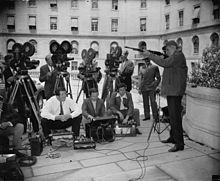History


Silent news films were shown in cinemas from the late 19th century. In 1909 Pathé started producing weekly newsreels in Europe. Pathé began producing newsreels for the UK in 1910 and the US in 1911. [2]
Newsreels were a staple of the typical North American, British, and Commonwealth countries (especially Canada, Australia, and New Zealand), and throughout European cinema programming schedule from the silent era until the 1960s when television news broadcasting completely supplanted its role. The National Film and Sound Archive in Australia holds the Cinesound Movietone Australian Newsreel Collection, a comprehensive collection of 4,000 newsreel films and documentaries representing news stories covering all major events.
The first official British news cinema that only showed newsreels was the Daily Bioscope that opened in London on May 23, 1909. [3] In 1929, William Fox purchased a former cinema called the Embassy. [4] He changed the format from a $2 show twice a day to a continuous 25-cent programme, establishing the first newsreel theater in the United States; the idea was such a success that Fox and his backers announced they would start a chain of newsreel theaters across the country. [5] [lower-alpha 1] The newsreels were often accompanied by cartoons or short subjects.
The First World War saw the major countries using the newest technologies to develop propaganda for home audiences. Each used carefully edited newsreels to combine straight news reports and propaganda. [6] [7] [8] During the Second World War, the Reich Ministry of Public Enlightenment and Propaganda, a state organization in Nazi Germany for disseminating stories favorable to the administration's goals, created Die Deutsche Wochenschau (1940–1945). There were no other newsreels disseminated within the country during the war.
In some countries, newsreels generally used music as a background for usually silent on-site film footage. In some countries, the narrator used humorous remarks for light-hearted or non-tragic stories. In the U.S., newsreel series included The March of Time (1935–1951), Pathé News (1910–1956), Paramount News (1927–1957), Fox Movietone News (1928–1963), Hearst Metrotone News (1914–1967), and Universal Newsreel (1929–1967). Pathé News was distributed by RKO Radio Pictures from 1931 to 1947, and then by Warner Brothers from 1947 to 1956.
An example of a newsreel story can be found in the film Citizen Kane (1941), which was prepared by RKO's actual newsreel staff. Citizen Kane includes a fictional newsreel called "News on the March" that summarizes the life of title character Charles Foster Kane while parodying The March of Time .
On August 12, 1949, one hundred twenty cinema technicians employed by Associated British Pathé in London went on strike to protest the dismissal of fifteen men on the grounds of redundancy while conciliation under trade union agreements was pending. Their strike lasted through to at least Tuesday August 16, the Tuesday being the last day for production on new newsreels shown on the Thursday. Events of the strike resulted in over three hundred cinemas across Britain having to go without newsreels that week. [9]









